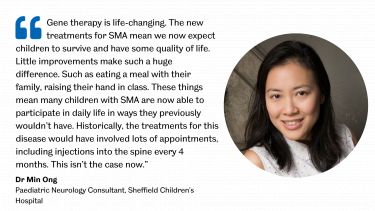You can be part of success stories like Spinal Muscular Atrophy
Learning your child has a severe medical condition that will drastically reduce their life-expectancy is devastating. But pioneering gene therapy is already helping some children live happier, healthier lives.

Spinal Muscular Atrophy (SMA) is a genetic neuromuscular disease and the most common genetic causes of death in childhood. It’s most often noticed in the first months of life as babies being floppy. Tragically for children with the most severe forms, without treatment, many aren’t expected to live past their second birthday.
Every year, around 80 babies a year are born in the UK with SMA. For families who receive a diagnosis, the natural first question is, “what can we do?” And for so long, the answer was bleak. Dr Min Ong, Paediatric Neurology Consultant at Sheffield Children’s Hospital, cares for these children and has seen the pain a severe diagnosis brings.
It’s disastrous news. Particularly because the children are cognitively normal. They’re aware of their surroundings but physically they’re just too weak. It’s incredibly sad and heartbreaking.”
Dr Min Ong
Paediatric Neurology Consultant at Sheffield Children’s Hospital
Physiotherapy and some medications can help ease symptoms up to a point. But for children with the most severe forms of the disease, deterioration of muscle control eventually prevents them from moving, eating and even breathing unaided. Before long, repeated hospitalisation would be the norm, as feeding tubes and ventilators are used to keep the child alive. This unimaginable situation is something no parent ever wants to consider.
But thanks to revolutionary gene therapy, there's now a treatment that really works. It doesn't just mask symptoms. It's saving lives. And with so much potential for gene therapy to help similar conditions, Sheffield’s world-leading research teams are determined to help as many families as possible.
Knowing the science is there means everything to parents. Seeing gene therapy in action is everything. By supporting this appeal, you’ll give so many families hope in the darkest of times. Please help if you can.
The miracle of gene therapy
- What causes Spinal Muscular Atrophy?
-
SMA causes loss of nerve cells in the spinal cord and is classified as a childhood form of motor neuron disease. In the most common form of SMA, mutation or loss of genes prevents the production of a protein called SMN. Our bodies need this protein to maintain healthy, functional motor neurons. Because they’re the messengers that send signals to our muscles to help us move. Without SMN proteins or functional motor neurons, muscles weaken and become smaller.
Most types of SMA follow an inheritance pattern known as autosomal recessive. Recessive conditions like this require two gene flaws — usually one from each parent. Despite 1 in 50 adults having this gene flaw, often parents have no idea they are carriers until their child is born. For those parents who are both carriers, there’s a 1 in 4 chance their baby will be born with the condition.
- What research has taken place?
-
Over the last decade, the University of Sheffield’s Professor Mimoun Azzouz has pioneered gene replacement therapy for Spinal Muscular Atrophy. His ground-breaking preclinical work supported and gave confidence to start human gene therapy trials for SMN protein replacement.
In 2017, successful human clinical trials showed protein replacement therapy could significantly improve outcomes for children with SMA. Not long after, Zolgensma® was made available in the US and the UK to treat patients under two. This life-saving medicine is proof that gene therapy works and the research undertaken by Professor Azzouz and his colleagues is truly at the forefront of modern medicine
- How does the treatment work?
-
Zolgensma® works by introducing a harmless, genetically engineered virus into the patient. This virus travels around the body to deliver the missing proteins to some of the nerve cells. These can then start to produce motor neurons that can function as they should so the child can gain control of their muscles.
The therapy itself is injected into the child’s bloodstream via a drip and takes around one hour to administer. Side effects of the treatment can make them feel like they have a bad cold. However, this can help them get stronger. They need physiotherapy to help their muscle function. And medical contact is only reduced once a consultant is happy with the gains they’ve made
- How quickly do patients see a difference?
-
Because the severity of the condition in each patient varies, so does the amount of time it takes to see an improvement. However, on the whole motor improvements and moving can happen quite quickly. Some families notice subtle changes a few weeks after the treatment. For example, patients with a persistent cough have had this disappear almost immediately.
From six months on patients would expect to see significant improvements. For example, with physiotherapy toddlers with SMA are now able to sit up on their own. And over the last few years, none of those who have received the treatment have exhibited any further deterioration to motor function. Therefore it’s hopeful these children will go on to walk and develop their speech
- What else can we do?
-
Professor Azzouz and his team are working with consultants such as Dr Ong to explore more options for using gene therapy. There are lots of other neurological conditions, many of which affect children, that could benefit from this type of treatment. Including SPG47 and COL4A1.
However, there are many, many adults living with the strain of a genetic disease that could benefit too. Including individuals with motor neurone disease, epilepsy, dementia and age-related hearing loss.
Bringing together researchers and clinicians to collaborate is vital. And it’s exactly this work that the Gene Therapy Innovation and Manufacturing Centre (GTIMC) will enable. Sharing knowledge and having access to the most up-to-date science and technology makes it possible to discover even more treatments. Over time these treatments will reduce the health burden on the country. And patients will have the chance to participate more in life.
Caring about people living with untreatable conditions, means believing in the research that can help them. Please support this work today and help researchers make more discoveries like this.


